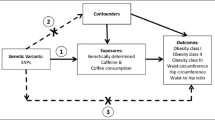Abstract
The effect of caffeine exposure on children’s health remains poorly understood. We aimed to characterize the associations of caffeine and caffeine metabolites with adiposity outcomes among children and adolescents. We performed cross-sectional analyses of 1,447 children and adolescents aged 6–19 years from the 2009–2014 National Health and Nutrition Examination Survey. The linear regression and weighted quantile sum (WQS) regression were used to explore the associations of urinary caffeine and 14 caffeine metabolites with adiposity outcomes, including body mass index (BMI) z-score, waist circumference (WC), obesity, and overweight. In linear regression models, compared with the participants who consumed low caffeine, higher BMI z-score, WC, and risks of obesity and overweight were more likely among those who consumed high caffeine (P < 0.05). In WQS regression models, an interquartile range increase in the weighted caffeine index was significantly associated with increased BMI z-score (β = 0.10, 95% CI = 0.01, 0.17) and WC (β = 1.20, 95% CI = 0.31, 2.09), and risks of obesity (OR = 1.09, 95% CI = 1.02, 1.17). Totally, no modification effect of age or gender was observed in the linear regression model. Nonetheless, in WQS models, the positive associations of caffeine exposure with WC and risks of obesity and overweight were significant in children aged 6–11 years rather than 12–19 years. When stratified by gender, caffeine exposure was significantly associated with BMI z-score and WC in both boys and girls. These results add novel evidence that caffeine exposure might be associated with adverse adiposity outcomes among children and adolescents.


Similar content being viewed by others
Data Availability
No additional data available.
References
Albrecht JN, Werner H, Rieger N, Widmer N, Janisch D, Huber R, Jenni OG (2022) Association between homeschooling and adolescent sleep duration and health during COVID-19 pandemic high school closures. JAMA Netw Open 5:e2142100
Ali MK, Bullard KM, Beckles GL, Stevens MR, Barker L, Narayan KMV, Imperatore G (2011) Household income and cardiovascular disease risks in U.S. children and young adults: analyses from NHANES 1999–2008. Diabetes Care 34:1998–2004
Anonymous (2013) Children, adolescents, and the media. Pediatrics 132:958–961
Berkey CS, Rockett HR, Colditz GA (2008) Weight gain in older adolescent females: the internet, sleep, coffee, and alcohol. J Pediatr 153(635–9):639.e1. https://doi.org/10.1016/j.jpeds.2008.04.072
Bracken MB, Triche E, Grosso L, Hellenbrand K, Belanger K, Leaderer BP (2002) Heterogeneity in assessing self-reports of caffeine exposure: implications for studies of health effects. Epidemiology (Cambridge, Mass.) 13:165–71
Branum AM, Rossen LM, Schoendorf KC (2014) Trends in caffeine intake among U.S. children and adolescents. Pediatrics 133:386–393
Calamaro CJ, Yang K, Ratcliffe S, Chasens ER (2012) Wired at a young age: the effect of caffeine and technology on sleep duration and body mass index in school-aged children. J Pediatr Health Care 26:276–282. https://doi.org/10.1016/j.pedhc.2010.12.002
Carrico C, Gennings C, Wheeler DC, Factor-Litvak P (2015) Characterization of weighted quantile sum regression for highly correlated data in a risk analysis setting. J Agric Biol Environ Stat 20:100–120
CDC (2011) Centers for Disease Control and Prevention. http://www.cdc.gov/nccdphp/dnpao/growthcharts/resources/sas. Accessed 10 Dec 2021
CDC (2014) National Health and Nutrition Examination Survey (NHANES) 2013–2014 Laboratory Methods. https://wwwn.cdc.gov/nchs/nhanes/continuousnhanes/labmethods.aspx?BeginYear=2013. Accessed 10 Dec 2021
CDC (2020) National Health and Nutrition Examination Survey (NHANES) Caffeine and caffeine metabolites - Urine Lab Procedure Manual. https://wwwn.cdc.gov/Nchs/Nhanes/2013-2014/CAFE_H.htm. Accessed 10 Dec 2021
CDC (n.d.) National Health and Nutrition Examination Survey (NHANES) Sample design. https://wwwn.cdc.gov/nchs/nhanes/tutorials/module2.aspx. Accessed 10 Dec 2021
Cole TJ, Freeman JV, Preece MA (1995) Body mass index reference curves for the UK, 1990. Arch Dis Child 73:25–29
Cornelis MC et al (2015) Genome-wide meta-analysis identifies six novel loci associated with habitual coffee consumption. Mol Psychiatry 20:647–656
Dyer O (2021) Obesity in US children increased at an unprecedented rate during the pandemic. Bmj 374, n2332
Hagman E, Danielsson P, Elimam A, Marcus C (2019) The effect of weight loss and weight gain on blood pressure in children and adolescents with obesity. Int J Obes 43:1988–1994. https://doi.org/10.1038/s41366-019-0384-2
Kolnes AJ, Ingvaldsen A, Bolling A, Stuenaes JT, Kreft M, Zorec R, Shepherd PR, Jensen J (2010) Caffeine and theophylline block insulin-stimulated glucose uptake and PKB phosphorylation in rat skeletal muscles. Acta Physiol (oxf) 200:65–74
Lee E, Kim HJ, Im JY, Kim J, Park HY, Ryu JY, Ko KR, Kim HS (2007) Survey of caffeine levels in the favorite diets of children. J Food Hyg Saf 22
Leproult R, Van Cauter E (2010) Role of sleep and sleep loss in hormonal release and metabolism. Endocr Dev 17:11–21
Lindberg L, Danielsson P, Persson M, Marcus C, Hagman E (2020) Association of childhood obesity with risk of early all-cause and cause-specific mortality: a Swedish prospective cohort study. PLoS medicine 17:e1003078
Liu Y, Xu D, Feng J, Kou H, Liang G, Yu H, He X, Zhang B, Chen L, Magdalou J, Wang H (2012) Fetal rat metabonome alteration by prenatal caffeine ingestion probably due to the increased circulatory glucocorticoid level and altered peripheral glucose and lipid metabolic pathways. Toxicol Appl Pharmacol 262:205–216
Lodato F, Araújo J, Barros H, Lopes C, Agodi A, Barchitta M, Ramos E (2013) Caffeine intake reduces sleep duration in adolescents. Nutr Res 33:726–732
Matthews KA, Dahl RE, Owens JF, Lee L, Hall M (2012) Sleep duration and insulin resistance in healthy black and white adolescents. Sleep 35:1353–1358
Nagata JM, Ganson KT, Liu J, Gooding HC, Garber AK, Bibbins-Domingo K (2021) Adolescent body mass index and health outcomes at 24-year follow-up: a prospective cohort study. J Am Coll Cardiol 77:3229–3231
NCHS (n.d.) National Health and Nutrition Examination. Survey Analytic Guidelines. https://wwwn.cdc.gov/nchs/nhanes/analyticguidelines.aspx. Accessed 10 Dec 2021
Nehlig A (2018) Interindividual differences in caffeine metabolism and factors driving caffeine consumption. Pharmacol Rev 70:384–411
Nurwanti E, Hadi H, Chang JS, Chao JC, Paramashanti BA, Gittelsohn J, Bai CH (2019): Rural-urban differences in dietary behavior and obesity: results of the Riskesdas Study in 10–18-Year-Old Indonesian Children and Adolescents. Nutrients 11
O’Connor TM, Yang SJ, Nicklas TA (2006) Beverage intake among preschool children and its effect on weight status. Pediatrics 118:e1010–e1018
Owens J (2014) Insufficient sleep in adolescents and young adults: an update on causes and consequences. Pediatrics 134:e921–e932
Purdue-Smithe AC, Kim K, Schliep KC, DeVilbiss EA, Hinkle SN, Ye A, Perkins NJ, Sjaarda LA, Silver RM, Schisterman EF, Mumford SL (2022): Preconception caffeine metabolites, caffeinated beverage intake, and fecundability. The American journal of clinical nutrition
Rybak ME, Sternberg MR, Pao CI, Ahluwalia N, Pfeiffer CM (2015) Urine excretion of caffeine and select caffeine metabolites is common in the U.S. population and associated with caffeine intake. J Nutr 145:766–774
Samoggia A, Rezzaghi T (2021): The consumption of caffeine-containing products to enhance sports performance: an application of an extended model of the theory of planned behavior. Nutrients 13
Scinicariello F, Buser MC (2014) Urinary polycyclic aromatic hydrocarbons and childhood obesity: NHANES (2001–2006). Environ Health Perspect 122:299–303
Skinner AC, Ravanbakht SN, Skelton JA, Perrin EM, Armstrong SC (2018): Prevalence of obesity and severe obesity in US children, 1999-2016. Pediatrics 141. https://doi.org/10.1542/peds.2017-3459
Smith JD, Fu E, Kobayashi MA (2020) Prevention and management of childhood obesity and its psychological and health comorbidities. Annu Rev Clin Psychol 16:351–378
Soós R, Gyebrovszki Á, Tóth Á, Jeges S, Wilhelm M (2021): Effects of caffeine and caffeinated beverages in children, adolescents and young adults: short review. Int J Environ Res Public Health 18
Spiegel K, Tasali E, Leproult R, Van Cauter E (2009) Effects of poor and short sleep on glucose metabolism and obesity risk. Nat Rev Endocrinol 5:253–261
Vernarelli JA, Mitchell DC, Rolls BJ, Hartman TJ (2013) Methods for calculating dietary energy density in a nationally representative sample. Procedia Food Sci 2:68–74
Verster JC, Koenig J (2018) Caffeine intake and its sources: a review of national representative studies. Crit Rev Food Sci Nutr 58:1250–1259
Wong M, Han YY, Rosser F, Acosta-Pérez E, Canino G, Forno E, Celedón JC (2022): Persistent overweight or obesity, lung function, and asthma exacerbations in Puerto Rican youth. Ann Allergy Asthma Immunol
Funding
Not applicable.
Author information
Authors and Affiliations
Contributions
L. Yu researched data and wrote the manuscript. H. Mei and D. Shi reviewed the manuscript. X. Wang, M. Cheng, L. Fan, and Y. Xiao contributed to the data acquisition, discussion and edited the manuscript. B. Wang, M. Yang, and W. Chen conceived and designed this study, researched data, and approved the final version of the manuscript.
Corresponding author
Ethics declarations
Ethical approval and consent to participate
The National Health and Nutrition Examination Survey protocol was approved by the National Center for Health Statistics Ethics Review Board and written informed consent was obtained from all participants.
Consent to publish
Not applicable.
Competing interests
The authors declare no competing interests.
Additional information
Responsible Editor: Lotfi Aleya
Publisher’s note
Springer Nature remains neutral with regard to jurisdictional claims in published maps and institutional affiliations.
Supplementary Information
Below is the link to the electronic supplementary material.
Rights and permissions
About this article
Cite this article
Yu, L., Mei, H., Shi, D. et al. Association of caffeine and caffeine metabolites with obesity among children and adolescents: National Health and Nutrition Examination Survey (NHANES) 2009–2014. Environ Sci Pollut Res 29, 57618–57628 (2022). https://doi.org/10.1007/s11356-022-19836-1
Received:
Accepted:
Published:
Issue Date:
DOI: https://doi.org/10.1007/s11356-022-19836-1




